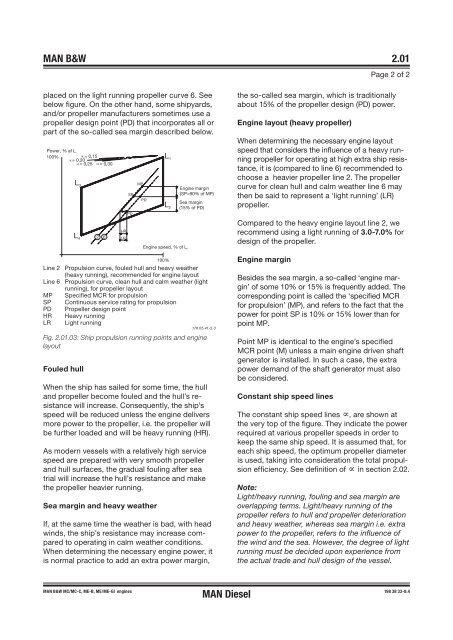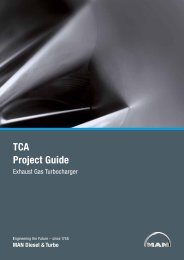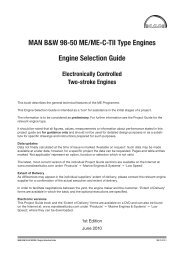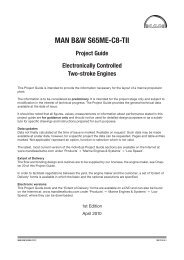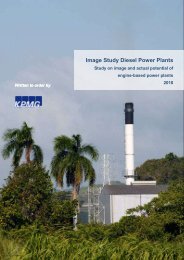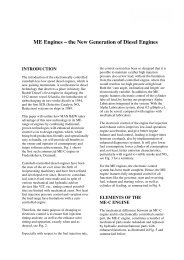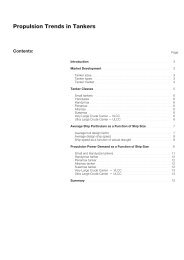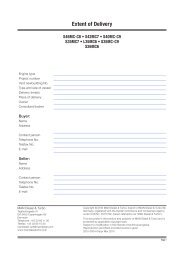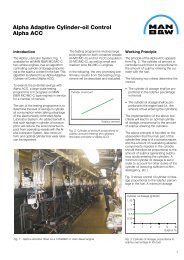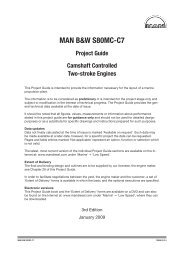This section is not applicable - MAN Diesel & Turbo
This section is not applicable - MAN Diesel & Turbo
This section is not applicable - MAN Diesel & Turbo
Create successful ePaper yourself
Turn your PDF publications into a flip-book with our unique Google optimized e-Paper software.
<strong>MAN</strong> B&W 2.01<br />
placed on the light running propeller curve 6. See<br />
below figure. On the other hand, some shipyards,<br />
and/or propeller manufacturers sometimes use a<br />
propeller design point (PD) that incorporates all or<br />
part of the so�called sea margin described below.<br />
Power, % af L<br />
00% = 0, 5<br />
= 0,20<br />
= 0,25 = 0,30<br />
L 3<br />
L 4<br />
2 6<br />
HR<br />
LR<br />
Fig. 2.01.03: Ship propulsion running points and engine<br />
layout<br />
<strong>MAN</strong> B&W MC/MC�C, ME-B, ME/ME�GI engines<br />
L 2<br />
Engine speed, % of L<br />
00%<br />
Engine margin<br />
(SP=90% of MP)<br />
Sea margin<br />
( 5% of PD)<br />
Line 2 Propulsion curve, fouled hull and heavy weather<br />
(heavy running), recommended for engine layout<br />
Line 6 Propulsion curve, clean hull and calm weather (light<br />
running), for propeller layout<br />
MP Specified MCR for propulsion<br />
SP Continuous service rating for propulsion<br />
PD Propeller design point<br />
HR Heavy running<br />
LR Light running<br />
Fouled hull<br />
When the ship has sailed for some time, the hull<br />
and propeller become fouled and the hull’s res<strong>is</strong>tance<br />
will increase. Consequently, the ship’s<br />
speed will be reduced unless the engine delivers<br />
more power to the propeller, i.e. the propeller will<br />
be further loaded and will be heavy running (HR).<br />
As modern vessels with a relatively high service<br />
speed are prepared with very smooth propeller<br />
and hull surfaces, the gradual fouling after sea<br />
trial will increase the hull’s res<strong>is</strong>tance and make<br />
the propeller heavier running.<br />
MP<br />
Sea margin and heavy weather<br />
SP<br />
PD<br />
PD<br />
L<br />
178 05 41�5.3<br />
If, at the same time the weather <strong>is</strong> bad, with head<br />
winds, the ship’s res<strong>is</strong>tance may increase compared<br />
to operating in calm weather conditions.<br />
When determining the necessary engine power, it<br />
<strong>is</strong> normal practice to add an extra power margin,<br />
<strong>MAN</strong> <strong>Diesel</strong><br />
Page 2 of 2<br />
the so�called sea margin, which <strong>is</strong> traditionally<br />
about 5% of the propeller design (PD) power.<br />
Engine layout (heavy propeller)<br />
When determining the necessary engine layout<br />
speed that considers the influence of a heavy running<br />
propeller for operating at high extra ship res<strong>is</strong>tance,<br />
it <strong>is</strong> (compared to line 6) recommended to<br />
choose a heavier propeller line 2. The propeller<br />
curve for clean hull and calm weather line 6 may<br />
then be said to represent a ‘light running’ (LR)<br />
propeller.<br />
Compared to the heavy engine layout line 2, we<br />
recommend using a light running of 3.0�7.0% for<br />
design of the propeller.<br />
Engine margin<br />
Besides the sea margin, a so�called ‘engine margin’<br />
of some 0% or 5% <strong>is</strong> frequently added. The<br />
corresponding point <strong>is</strong> called the ‘specified MCR<br />
for propulsion’ (MP), and refers to the fact that the<br />
power for point SP <strong>is</strong> 0% or 5% lower than for<br />
point MP.<br />
Point MP <strong>is</strong> identical to the engine’s specified<br />
MCR point (M) unless a main engine driven shaft<br />
generator <strong>is</strong> installed. In such a case, the extra<br />
power demand of the shaft generator must also<br />
be considered.<br />
Constant ship speed lines<br />
The constant ship speed lines ∝, are shown at<br />
the very top of the figure. They indicate the power<br />
required at various propeller speeds in order to<br />
keep the same ship speed. It <strong>is</strong> assumed that, for<br />
each ship speed, the optimum propeller diameter<br />
<strong>is</strong> used, taking into consideration the total propulsion<br />
efficiency. See definition of ∝ in <strong>section</strong> 2.02.<br />
Note:<br />
Light/heavy running, fouling and sea margin are<br />
overlapping terms. Light/heavy running of the<br />
propeller refers to hull and propeller deterioration<br />
and heavy weather, whereas sea margin i.e. extra<br />
power to the propeller, refers to the influence of<br />
the wind and the sea. However, the degree of light<br />
running must be decided upon experience from<br />
the actual trade and hull design of the vessel.<br />
198 38 33�8.4


